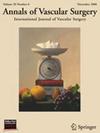The Predictive Value of the CHA2DS2-VASc Score in the Development of Contrast-Induced Nephropathy after Endovascular Intervention in Peripheral Artery Disease
IF 1.4
4区 医学
Q3 PERIPHERAL VASCULAR DISEASE
引用次数: 0
Abstract
Background
Contrast-induced nephropathy (CIN) is a frequent complication of endovascular interventions for peripheral artery disease (PAD). It is linked to renal dysfunction, extended hospital stays, increased cardiovascular events, and higher mortality rates. The CHA2DS2-VASc score, widely utilized for assessing cardioembolic risk and guiding anticoagulation therapy in nonvalvular atrial fibrillation, encompasses risk factors that overlap with those of CIN. This study investigates whether the CHA2DS2-VASc score can predict CIN in PAD patients undergoing endovascular interventions.
Methods
The study included 754 consecutive PAD patients who underwent endovascular procedures at 2 centers. Each patient's CHA2DS2-VASc score was calculated and categorized into low (<3) and high (≥3) groups. Patients were retrospectively monitored for CIN development and divided into CIN-positive (CIN+) and CIN-negative (CIN−) groups. Univariate and multivariate regression analyses were performed to identify independent predictors of CIN, and a significance level of P < 0.05 was used for all statistical analyses.
Results
Of the 754 patients, 178 (23.6%) developed CIN, with 151 (84.8%) occurring in the high CHA2DS2-VASc score group (P < 0.001). The CHA2DS2-VASc score was significantly higher in the CIN(+) group compared to the CIN(−) group (P < 0.001). Regression analysis identified the CHA2DS2-VASc score (odds ratio [OR]: 1.574, 95% confidence interval [CI]: 1.298–1.907, P < 0.001), baseline creatinine (OR: 2.296, 95% CI: 1.580–3.335, P < 0.001), and hemoglobin (OR: 0.915, 95% CI: 0.844–0.992, P < 0.001) as independent risk factors. A CHA2DS2-VASc score cutoff of 2.5 predicted CIN with 85% sensitivity and 42% specificity.
Conclusion
The CHA2DS2-VASc score is an independent predictor of the development of CIN in patients with PAD undergoing endovascular intervention.
CHA2DS2-VASc 评分对外周动脉疾病血管内介入治疗后对比度诱发肾病的预测价值。
本文章由计算机程序翻译,如有差异,请以英文原文为准。
求助全文
约1分钟内获得全文
求助全文
来源期刊
CiteScore
3.00
自引率
13.30%
发文量
603
审稿时长
50 days
期刊介绍:
Annals of Vascular Surgery, published eight times a year, invites original manuscripts reporting clinical and experimental work in vascular surgery for peer review. Articles may be submitted for the following sections of the journal:
Clinical Research (reports of clinical series, new drug or medical device trials)
Basic Science Research (new investigations, experimental work)
Case Reports (reports on a limited series of patients)
General Reviews (scholarly review of the existing literature on a relevant topic)
Developments in Endovascular and Endoscopic Surgery
Selected Techniques (technical maneuvers)
Historical Notes (interesting vignettes from the early days of vascular surgery)
Editorials/Correspondence

 求助内容:
求助内容: 应助结果提醒方式:
应助结果提醒方式:


